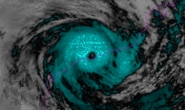Logistics

September 16, 2018
Florence Impacts Freight Flows, Volumes, Rates
Written by Sandy Williams
Hurricane Florence is expected to take a toll on shipments from the Carolinas and Virginia. In the aftermath of Hurricane Harvey, trucks were in short supply for regular freight shipments as many were diverted to the storm-affected areas to help with recovery efforts. If Florence causes similar damage, that scenario could be repeated.
Truckload spot rates surged in advance of the storm with flatbed rates jumping 13 percent from the seven-day average on Sept. 12, according to DAT Trendlines.
Rates are expected to return to normal after the storm subsides, said JOC.com. During Hurricane Harvey, the impact was prolonged due to the higher concentration of distribution centers in the Atlanta area. Unless there is significant damage to Charlotte or Norfolk, said DAT industry analyst Mark Montague, the impact on freight flows will be more like Hurricane Irma.
The Federal Motor Carriers Safety Administration has suspended the hours-of-service regulation for drivers who provide emergency relief assistance.
Major weather events generally affect the spot market in three stages, said DAT Trendlines. Before the storm, volumes go up as freight is moved out of the region and emergency supplies are directed inward. Volume drops while the storm hits, with FEMA freight housed in temporary warehouses outside of the storm area. Once the storm passes, van and reefer loads move in followed by flatbed loads of construction equipment and supplies. Rates temporarily increase for freight inbound to the hurricane area.
American Trucking Association President and CEO Chris Spear said the industry is ready to quickly respond to community needs following the storm. “As soon as it is safe to do so, trucks from around the country will begin delivering food, water, medicine and other goods essential to rebuilding and restoring communities,” said Spears.
Ports in the path of Florence have ceased operations during the storm and, depending on weather conditions, are expected to resume operations by Monday. Major ports in the path of the storm include Port of Wilmington (NC), Port of Charleston (SC) and Port of Norfolk (VA). Savannah has not announced any closures, but could see heavy rain.
Terminals in Wilmington will be shut down until at least Monday. Norfolk Southern Railway and CSX Transportation closed terminals in Charleston ahead of the storm.
“From an intermodal perspective, a disruption in Savannah or Norfolk would be worse on a regional basis than in Charleston and Wilmington,” wrote Ari Ashe, JOC.com associate editor. “Rail in Georgia and Virginia feeds the Midwest more often than North or South Carolina.”
The Association of American Railroads is working with Homeland Security, FEMA and the Federal Railroad Administration to ensure rapid response to infrastructure damage and assist with emergency relief and recovery efforts.





